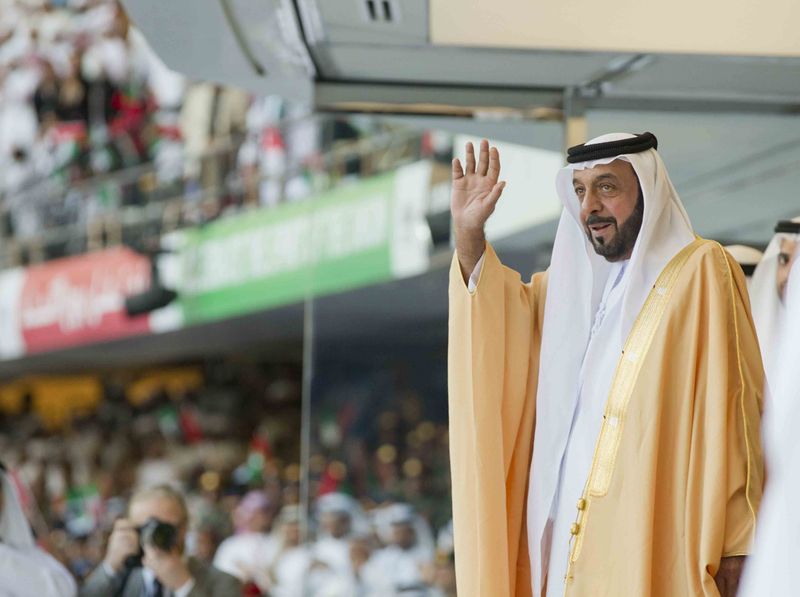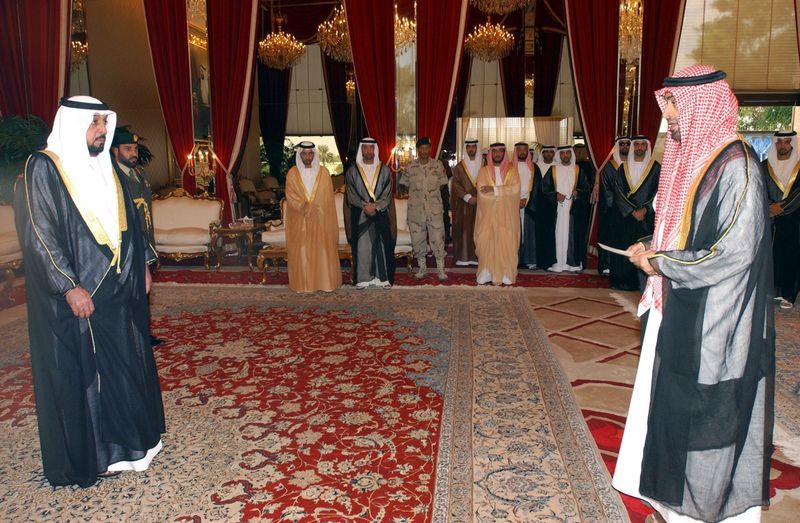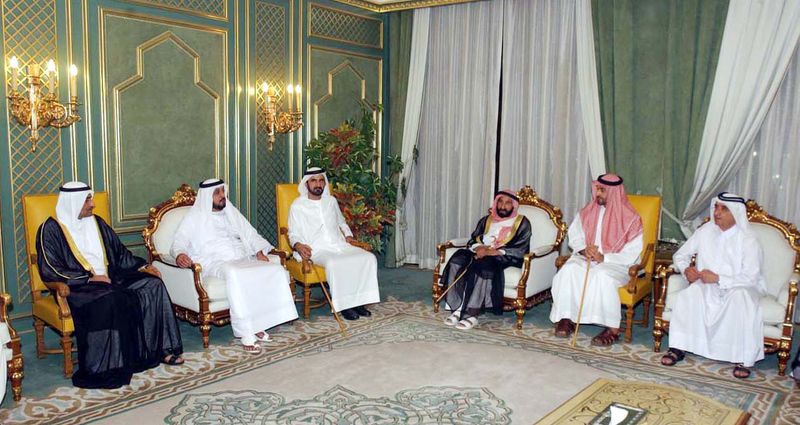
Abu Dhabi: The UAE Supreme Council has re-elected His Highness Shaikh Khalifa Bin Zayed Al Nahyan as President of the UAE for a fourth five-year term. The Council expressed its deep confidence in the wise leadership of the President, the Council statement said, praying that he would continue to lead the UAE to strengthen the pillars of the Union and its prosperity and fulfil the aspirations of its honourable people, WAM reported.
Shaikh Khalifa was first elected President on November 3, 2004 following the death of his father Shaikh Zayed Bin Sultan Al Nahyan. “President Khalifa accompanied the builder of the UAE renaissance, the late Shaikh Zayed, in the founding stage in the 70s and 80s of the last century before taking over the leadership of the country after the death of the Founding Father.”
“[He] led the country towards the achievement stage that contributed to empowering the Emirati citizens, and the prosperity of the UAE, and its prominence locally and globally,” the Council statement added.
About Sheikh Khalifa
Sheikh Khalifa was born in Al Muwaiji Fort, Al Ain, in 1948. Though Al Muwaiji village was then a small place compared to the other villages in the cluster of oases dominated by Al Ain and Al Buraimi, it was, nevertheless, a centre of influence for the Al Bu Falah subsection of the Bani Yas tribal confederation and the Al Nahyan ruling family in the numerous oases of the Eastern Region of Abu Dhabi as well as in the interior of eastern Arabia.
Sheikh Khalifa spent his early childhood years in this fort, which still stands opposite the Court (diwan) of the Ruler’s Representative on the outskirts of Al Ain, and in which his late father had settled in his youth in 1946 after being assigned by his brother, Sheikh Shakhbout Bin Sultan Al Nahyan, to be the Ruler’s Representative in the Eastern Region.
The oases of Al Ain and Al Buraimi, where Sheikh Khalifa spent his early years, were places of strategic and vital economic significance for Abu Dhabi as main agricultural producers and major strategic centres for the security of the region, positioned at the crossroads that linked the coast to the interior of eastern Arabia.

The very difficult task of Sheikh Zayed at that time was to take leadership of the discordant tribes there and in the surrounding region, to ensure internal stability and security, to consolidate state authority, and to bring prosperity to the tribes despite the paucity of resources.
Public office
After Sheikh Zayed became Ruler of Abu Dhabi in 1966, he appointed Sheikh Khalifa as Ruler’s Representative in the Eastern Region, a delegation of authority that was seen as a mark of the high confidence he had in his son, who started his long career in public service with skill.
On February 1, 1969, Sheikh Khalifa was named Crown Prince of Abu Dhabi. He was named a day later to head the defence department of the emirate, coinciding with the formation of the Abu Dhabi Defence Force, which was later to form the nucleus of the UAE Armed Forces. In May 1976, he was named Deputy Supreme Commander of the UAE Armed Forces.
Achievements
Sheikh Khalifa’s character and ideals are based on his father, from whom he learnt and gained experience in leadership. Therefore he was well able to take on his new responsibilities when became the ruler of the Abu Dhabi following Shaikh Zayed’s death on November 2, 2004, and the next day was elected UAE President and Supreme Commander of the Armed Forces by the Supreme Council members.

Throughout his long years in government, Sheikh Khalifa has exhibited the same unique characteristics inspired by his father, based on a modest and open management style. In the region, Sheikh Khalifa is a strong supporter of the six-member Gulf Cooperation Council, believing that the success and achievements of this body reflect the depth of understanding reached amongst its leaders.
A keen supporter of the regional policy of Sheikh Zayed, in particular in terms of promoting solidarity between the Arab states, Sheikh Khalifa is firmly committed to support of the Palestinian people and also of moves designed to promote and restore stability in Iraq.
His key objective as UAE President, Sheikh Khalifa said, is to continue on the path set down by his father. In particular, he said, he would continue with the ‘open door’ policy and with the practice of holding regular consultations with the country’s citizens, so that he may become aware of, and follow up on, their needs and concerns.

When the UAE and Dubai were awarded the right to host Expo 2020, Sheikh Khalifa expressed pride at the international recognition in the following words:
“It is a day of expressing our gratitude to great men, who laid down the foundation of a successful state whose achievements have taken the world by surprise and for providing its citizens with sources of strength and welfare,” he said.
Federation and people
While guiding the UAE through chaotic politics and economics, Sheikh Khalifa did not lose sight of his underlying long-term strategy of building a nation of active citizens, well-educated, committed and involved in the spirit of the UAE’s federation. Time and again, Sheikh Khalifa has made clear his faith in the young people of the emirates being able and ready to pick up the challenge of taking their country forward.
Sheikh Khalifa has been committed to the natural evolution of the Federal National Council (FNC) to take on more responsibilities and become more representative of the people as a whole. He has also been committed to building and maintaining a world class education system for Emiratis.
In 2005, Sheikh Khalifa summarised his concept of an active citizen when he said, “It is high time to make the UAE people understand the true meaning of work — that it means responsibility and reflects human, civil and religious values. Our institutions also need to work hard to diversify the skills of the national human resources, to raise productivity, encourage investment in human resources development, improve voluntary work and create awareness on this noble work and its significance to individuals and society in general.”
It was in 2006, two years after Sheikh Khalifa took office, that the FNC had its first elections when half the members were voted into office by a small electoral college. In 2008, the Supreme Council passed some amendments to the UAE constitution which gave the FNC more powers and improved government transparency.
Inclusive government
In 2011, the FNC elections involved a much wider selection of the population. Sheikh Khalifa made it clear that the intention was to move to full elections, including all UAE adults. On the occasion of the UAE’s 40th National Day the same year, Sheikh Khalifa made clear the leadership’s commitment to a more inclusive government. “We assert that broadening popular participation is a firm national trend and an irrevocable option which we have chosen with our full will. We will continue to take it forward gradually and steadily in response to the aspirations of our people for a homeland in which they can come forward together to serve and develop society,” he said.
Sheikh Khalifa was referring to the success of the 2011 elections when he added that the UAE has successfully completed the second phase of this gradual approach. “We adopted a method to expand popular participation in elections and to empower the FNC and increase its powers and enhance its role. This phase was crowned with the election of a new FNC which has commenced its sessions as a more vocal organ of national will.
In an interview with Diraa Al Watan magazine, Sheikh Khalifa said: “We hope that the FNC will perform its role in complete cooperation with the executive authority as a responsible platform for national issues and with a positive impact in decision-making.”
UAE traditions
Throughout his life, Sheikh Khalifa has paid great attention to Emirati tradition. In 1992, he said at a military graduation ceremony that “the wonderful cohesion between the leadership and the people of the UAE though not new should not pass unnoticed.
“It deserves contemplation and study to benefit from it, especially as we set out towards a new future that will require great responsibilities from all of us”.
Sheikh Khalifa has maintained this stance as president, which was hailed by His Highness Sheikh Mohammad Bin Rashid Al Maktoum, Vice-President and Prime Minister of the UAE and Ruler of Dubai, who said in November 2013 that “the principle of Shura as the basis of good governance has been part of the UAE since its very early history. Working with that, the Ruler’s majlis was the first brick in the system of democratic practice initiated by Emiratis for a very long time”.
He added: “After the establishment of the UAE, the Federal National Council emerged to set the official framework for this practice through organised structure with ruling principles, rules and laws that laid the foundation for a wider societal participation, which we go forward to achieve, but in a carefully planned manner, that ensures the safety of the empowerment process initiated by my brother, President His Highness Sheikh Khalifa Bin Zayed Al Nahyan since 2006.”
United in the face of adversity
In 2009, Sheikh Khalifa’s commitment to the UAE’s unity ensured that investor confidence was restored in Dubai after several of its over-borrowed companies were hit by the global financial crisis.
At the height of the crisis in April 2009, Sheikh Khalifa made a rare visit to Dubai, accompanied by a delegation of senior Sheikhs, who had played substantial roles in government for many years. He was welcomed by Sheikh Mohammad. They toured various economic zones and then stood together in front of Union House, exactly the same place where their fathers had stood in 1971 to sign the treaty which brought the UAE into existence.
The photo call was a powerful reminder of the economic and political success that has built the UAE.
Just in case the symbolism was not enough to reassure any doubters, Sheikh Khalifa made it clear in a statement that the federal government and the Abu Dhabi leadership were at ease with what was happening in Dubai.

He said that Dubai’s development plans “provide direct support to the national economy and the country’s sustainable development”, and added that the vision of Sheikh Mohammad complements the strategy of the leadership and government of the UAE.
Sheikh Khalifa said: “Sheikh Mohammad’s vision is an inseparable part of the government’s comprehensive strategy, which the country’s leadership is striving to maximise so as to improve the living conditions of the citizen, education standards and provide all factors of stability and strength to our citizens.”
The Dubai Government went on to launch a $20 billion (Dh73.56 billion) bond issue, of which the UAE Central Bank subscribed to $10 billion. This, combined with Sheikh Khalifa’s direct intervention, gave Dubai’s companies the all-important liquidity they needed to see themselves through the crisis.
In Abu Dhabi
Ever since he assumed office as the 15th Ruler of Abu Dhabi in 2004, Sheikh Khalifa Bin Zayed Al Nahyan led the transition of the emirate to become an economic powerhouse and leading global hub for innovations in renewable energy, clean technology and the environment.
Abu Dhabi is the largest of the seven emirates which comprise the UAE.
Sheikh Khalifa redefined the emirate’s economic and social strategy to include the continuing development of its huge oil industry, diversification of the economy into new areas, and developing the potential of citizens by providing them the best education and more opportunities.
Sheikh Khalifa assumed public duties as soon as he was old enough, and eventually spent more than five decades in the service of the homeland and citizens.
He was intimately involved in the creation of the UAE, supporting his father Sheikh Zayed as he guided negotiations between the nine emirates (the future seven which joined the UAE and Qatar and Bahrain) which had all signed an agreement to create a federation in 1968.
Even after some years of negotiations, there were still important outstanding issues, so in October 24, 1970, the 22-year-old Sheikh Khalifa called a meeting of the deputy rulers of the nine emirates. He had the difficult job of seeking resolution of several contentious issues, like where the capital of the new country would be, and how the various emirates would be represented in the Union Council.
Governance
As Ruler of Abu Dhabi, Sheikh Khalifa has overseen dramatic changes in the government, where particular attention was paid to improvements in efficiency and delivering cost-effective services to the public and opening up much of the economy so that there was greater scope for direct private investment and public-private partnerships. With a burgeoning private sector and a well-educated population, Sheikh Khalifa’s policy is that the time is right for the government to step back and concentrate on core areas of governance.
Active citizenship
One of the major themes of Sheikh Khalifa’s leadership has been encouraging and promoting active citizenship. He has stressed that restructuring the government would only be effective if the people of the UAE take it upon themselves the task of contributing effectively.
“We have already begun preparing for the new era by promulgating legislation [and] placing some regulatory measures on the existing departments, institutions, activities and relations,” Sheikh Khalifa said in his December 2005 National Day message. “This is to tighten up the loose ends, to straighten the curves, put an end to wrongdoings [and] … to improve production and services.”
He added: “It is high time for our political, religious, cultural, information, educational and civil society institutions to take up their responsibilities to instil in our society the values of work, to change the negative perceptions about vocational activities.
“It is high time to make them understand the true meaning of work — that it means responsibility and reflects human, civil and religious values. These institutions also need to work hard to diversify the skills of the national human resources, to raise productivity, encourage investment in human resources development, improve voluntary work and create awareness on this noble work and its significance to individuals and society in general.”
Sheikh Khalifa has increased expenditure on the development of infrastructure throughout the emirate, improving education, housing, health and social welfare.
This care for the well-being of citizens led to the launch of a number of funds and initiatives targeted at developing the local workforce, granting financial and other assistance to budding entrepreneurs, assisting the agricultural sector, providing housing and alleviating the burden of private debt for citizens with low incomes.
Renewables
Under Sheikh Khalifa’s leadership, Abu Dhabi made a decisive shift in its economy by using its oil wealth to promote alternatives to hydrocarbons, both for its own long-term security and as a conscious contribution to the worldwide effort to reduce carbon emissions and deal with global warming.
In Masdar City, Abu Dhabi built a test case for an entirely energy self-sufficient urban landscape, which has become a focus of worldwide attention from experts and companies interested in seeing how their ideas play out on such a large scale.
10 new industries
With the population of Abu Dhabi expected to grow substantially in the next few decades and thousands of young people entering the employment market, it is imperative that its economy diversifies from its reliance on oil and hydrocarbons, which does not need a large labour force.
This is why the emirate’s 2030 Economic Vision calls for the non-oil sector to reach 64 per cent of the economy, well up from 44 per cent in 2010. Developing a new industrial base in globally strategic industries is the heart of Abu Dhabi’s plan to diversify away from oil, with a target of reaching 24 per cent of output by 2030 coming from industry.
- Inputs from WAM








